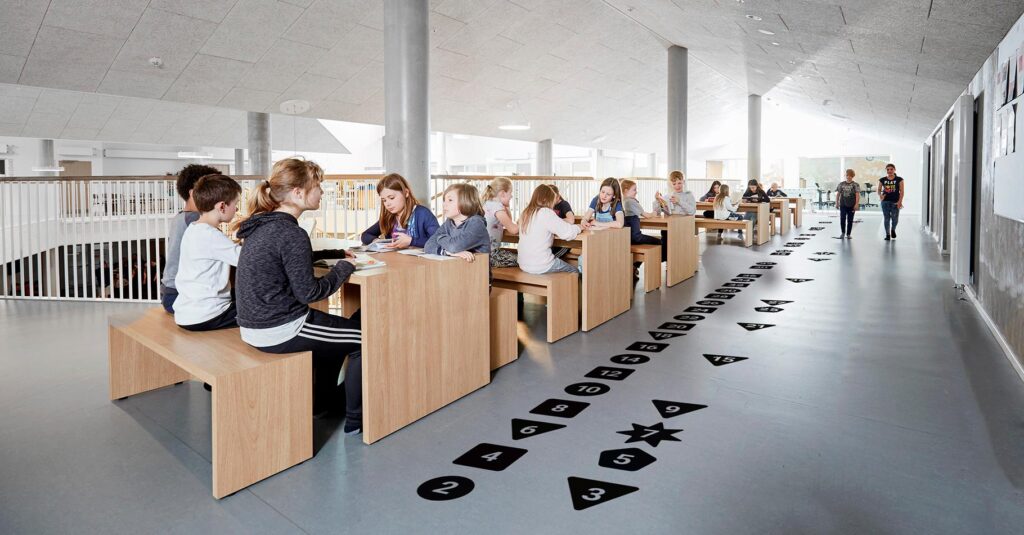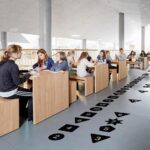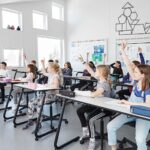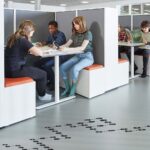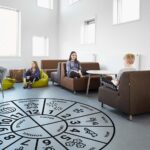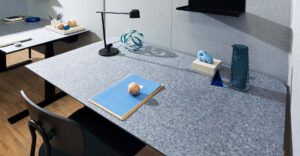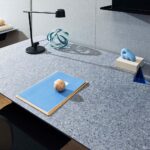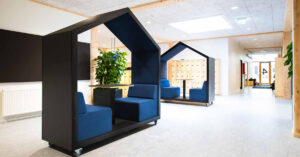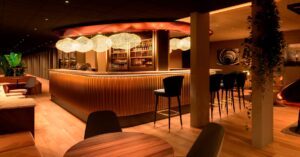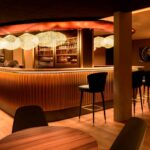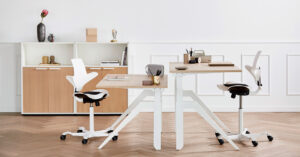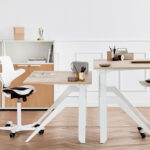Behavioural design – you might know it as nudging – is a well-known concept in the retail sector. But it can also be used in schools, where it can support requirements for more movement, promote different learning preferences and make learning more fun for pupils. And at HOLMRIS B8, a room is more than just a place where people gather. It is where people flourish. To thrive. To develop.
Our talented partners, NERD architects and Hello Monday, share here their thoughts on a new behavioural design product – visual learning environments – and its advantages for both pupils and teachers.
Requirements for movement and meaningful learning
The requirement of the Danish Primary and Lower Secondary School Reform for all pupils to get an average of 45 minutes of movement a day benefits pupils in many ways. Studies have repeatedly supported this in recent years.
At the same time, we know that children have different learning preferences. It is therefore important to be able to vary teaching methods and capture the interest of the individual pupil through meaningful teaching sessions.
As a natural extension of this, we see a need among teachers and educators for tools that support movement-oriented teaching and that make a connection between learning and the surroundings.
Visual learning environments increase motivation and learning
According to one report, one in four pupils is bored at school – and this affects their learning. One explanation may be that when pupils have difficulty decoding the purpose of the room, they also find it difficult to be engaged.
This is just some of the thinking that has motivated us to join forces with HOLMRIS B8 on the development of a series of visual learning environments that inspire curiosity to learn and serve as a concrete tool for teaching – in a new, creative and exciting way.
By using visual learning environments, you can create spaces that are coded to reflect a specific behaviour, with a design that enables the pupils to quickly decode what is possible in the space. Appealing to the senses helps boost motivation, energy and learning.
The third teacher
In addition to improving possibility of learning, visual learning environments enable the integration of movement throughout the school day.
- A long, straight hallway invites running, but by adding visual learning elements, it is possible to encourage both movement and learning – through play. One example is a multiplication table track on the floor, where the pupils can jump from number to number and learn their multiplication tables in a more physical, rhythmic and visual way – and they can also use the track to play hopscotch, of course.
- Patterns and spots on the floor can be combined with a stopwatch to create a different and fun way to get from A to B.
- Instead of telling the pupils they should move more, visual learning environments can nudge them by creating surroundings that encourage the students to jump, hop or skip from point to point down the hallway – they simply can’t help but use them.
Our brains tend to run on autopilot. But when the long, straight hallway is transformed into a visual learning environment and playground, that autopilot shuts off and we develop a desire to interact with it. Visual learning environments play an instructional role in relation to the pupils and thus act as a kind of third teacher.
Clear identity; high quality
Visual learning environments, or foils, are not a new phenomenon. They are used in various forms in many schools today. Many products on the market today tend to ‘talk down’ to pupils with loud colours and shapes that are more likely to pollute the physical teaching and working environment than to inspire and support it.
Our new series of foils is designed to underpin buildings and spaces and can be affixed to most surfaces without compromising the school’s architectural qualities or the rest of the furnishings.
The products are developed for different purposes within the categories:
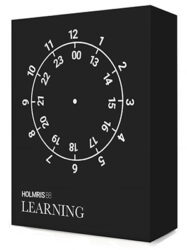
Learning
The learning product series comprises foils with clear educational content – providing a platform from which to teach.
With a year wheel placed on the floor, pupils can learn, through active involvement, about the seasons and how one year follows the next. They can stand on their birthday month and talk about cold and warm months – or they can see how many months older or younger they are than their classmates.
Similarly, the multiplication table tracks can be used to teach maths, allowing pupils with a kinaesthetic learning preference to learn and memorise their tables by walking, running or side-stepping, while pupils with a visual learning preference can learn and recognise the tables as patterns.
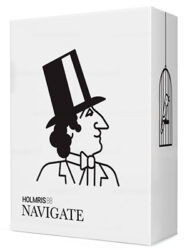
Navigate
These foils can serve as guides or help set the stage for the purpose of the space.
Many schools work with subject-specific academic environments in lower secondary classes, where strong coding and differentiation of the spaces makes it easier for pupils to decode the subject and the appropriate behaviour in relation to the classwork. Foils underpin the subject matter and can be used actively in connection with teaching, allowing both kinaesthetically and visually stimulated pupils to use the foils to learn the subject matter through patterns and movement.
The Navigate series can also give institutions or departments a clear identity, with the different themes and patterns serving as guides – for example a science room can have Niels Bohr or Einstein on the door.
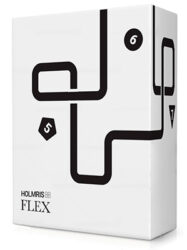
Flex & Play
The Flex series consists of simple graphic building blocks that can be combined in countless ways as needed and adapted to spaces of any size and shape. The series can also be combined with fixtures to create programmes to promote movement and that can be used in teaching of different exercises.
For instance, circles with numbers can be placed as multiplication tables or as a ‘ruler’ to measure how far the pupils can jump. With Flex & Play, pupils can also learn to combine patterns, forming a foundation for their own play.
And of course, the Flex series can be combined with the Learning and Navigate foils.
